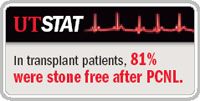Article
PCNL may be safe in high-risk patients
Recent studies in Egypt and the United States have found that percutaneous nephrolithotomy (PCNL) is safe and effective in selected high-risk patient populations.

Key Points

"PCNL under local anesthesia only is a safe and effective method for selected patients," said Alaa Shaaban, MD, a urologist at El-Minia University, Egypt. "Only two patients in our group did not tolerate the procedure under local anesthesia, and we proceeded successfully with them a week later under general anesthesia."


Once a PCNL guide wire was secured to the kidney, another 10 cc to 15 cc of lidocaine was injected along the PCNL track. The track was then dilated with high-pressure balloons or Alken's dilators, and stones were extracted using tricuspid forceps. Only two stones needed to be broken by lithotripsy before extraction, Dr. Shaaban reported. The entire procedure was guided by ultrasound.
The results were extremely positive, Dr. Shaaban said. Only two of 19 patients were unable to complete the procedure because of pain. Mean operative time was 48 minutes for 12 patients who were treated in a single session and 74 minutes in another five patients who required a staged PCNL. Patients were discharged the day after stone removal and no major complications were reported. Five patients had minor bleeding that did not require transfusion.
PCNL in transplant patients
PCNL is also emerging as an appropriate procedure for the minority of kidney transplantation patients who develop stones. Urologic surgeons at the University of Alabama, Birmingham have used PCNL in renal allograft patients for 19 years, said chief urology resident Joseph Wyatt, MD, who worked on the study under the direction of John R. Burns, MD.
Of the 16 renal allograft patients who received PCNL between 1986 and 2005, 13 (81%) were stone free after surgery at long-term follow-up. None of the 13 required additional treatment for urinary calculi during the follow-up period. The stone-free rate increased to 94% if patients with chronic infections or retained foreign objects, such as stents and prolene sutures, were excluded.
No complications, such as infection, sepsis, or delayed healing that are theoretically associated with immunosuppression, were observed.
"We have had a mean follow up of 7.2 years with these patients," Dr. Wyatt said. "Calculi are rare complications of renal transplants. The 81% stone-free rate compares very favorably to the reported 23% rate reported for single external shock wave lithotripsy treatment.
"Many of our renal transplant patients live 4 to 5 hours away," he continued. "Asking them to come in for [ESWL] treatment, going home, seeing if they pass the stone, and possibly coming back for further treatments is a tremendous inconvenience. PCNL offers our patients with a significant stone burden the best chance of being stone free with a single procedure."





